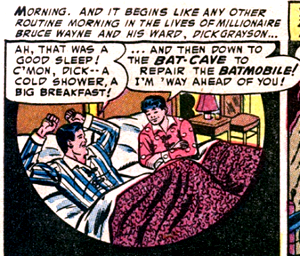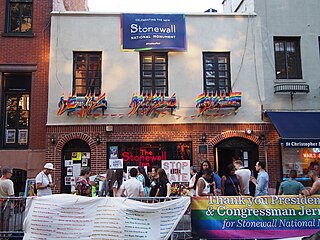The large amount of lists of LGBT characters and media within the scope of "fiction and myth", which has been divided into the following:
The large amount of lists of LGBT characters and media within the scope of "fiction and myth", which has been divided into the following:
These lists of television programs with LGBT characters include:

LGBT themes in speculative fiction include lesbian, gay, bisexual, or transgender (LGBT) themes in science fiction, fantasy, horror fiction and related genres. Such elements may include an LGBT character as the protagonist or a major character, or explorations of sexuality or gender that deviate from the heteronormative.
Lesbian, gay, bisexual, and transgender (LGBT) characters have been depicted in video games since the 1980s. In the history of video games, LGBT characters have been almost nonexistent for a long time, reflecting the overall heteronormativity of the medium. While there has been a trend towards greater representation of LGBT people in video games, they are frequently identified as LGBT in secondary material, such as comics, rather than in the games themselves. In 2018, Gamesradar’s Sam Greer pored through thousands of gaming titles and found 179 games with any LGBT representation: Of those 179 games, only 83 have queer characters who are playable characters. And of those, only eight feature a main character who is pre-written as queer as opposed to them being queer as an option.

Gay literature is a collective term for literature produced by or for the gay community which involves characters, plot lines, and/or themes portraying male homosexual behavior.
LGBT themes in horror fiction refers to sexuality in horror fiction that can often focus on LGBTQ+ characters and themes within various forms of media. It may deal with characters who are coded as or who are openly LGBTQ+, or it may deal with themes or plots that are specific to gender and sexual minorities. Depending on when it was made, it may contain open statements of gender variance, sexuality, same-sex sexual imagery, same-sex love or affection or simply a sensibility that has special meaning to LGBTQ+ people.

In comics, LGBT themes are a relatively new concept, as lesbian, gay, bisexual, and transgender (LGBT) themes and characters were historically omitted from the content of comic books and their comic strip predecessors due to anti-gay censorship. LGBT existence was included only via innuendo, subtext and inference. However the practice of hiding LGBT characters in the early part of the twentieth century evolved into open inclusion in the late twentieth and early twenty-first centuries, and comics explored the challenges of coming-out, societal discrimination, and personal and romantic relationships between gay characters.
In American mainstream comics, LGBT themes and characters were historically omitted intentionally from the content of comic books, due to either formal censorship or the perception that comics were for children and thus LGBT themes were somehow inappropriate. With any mention of homosexuality in mainstream United States comics forbidden by the Comics Code Authority (CCA) until 1989, earlier attempts at exploring these issues in the US took the form of subtle hints or subtext regarding a character's sexual orientation. LGBT themes were tackled earlier in underground comix from the early 1970s onward. Independently published one-off comic books and series, often produced by gay creators and featuring autobiographical storylines, tackled political issues of interest to LGBT readers.
Historically, the portrayal of lesbian, gay, bisexual, and transgender (LGBT) people in media have been negative, reflecting the cultural intolerance of LGBT individuals; however, from the 1990s to present day, there has been an increase in the depictions of LGBT people, issues, and concerns within mainstream media in North America. The LGBT communities have taken an increasingly proactive stand in defining their own culture, with a primary goal of achieving an affirmative visibility in mainstream media. The positive portrayal or increased presence of the LGBT communities in media has served to increase acceptance and support for LGBT communities, establish LGBT communities as a norm, and provide information on the topic.
Gay media refers to media that predominantly targets a gay, lesbian or LGBTQ+ allied audience. The primary target market for gay media may also more broadly be considered to include members of an LGBTQ+ community. Secondary targets are LGBTQ+ allies, and in some instances those who oppose gay rights may be targeted as a form of activism to change their minds. There are many types of gay media, and the type is determined by the purpose of the media presented. Gay or queer media can also be defined as web sites, films, magazines and other cultural products that were created by queer individuals, or groups that are typically out, meaning that they are public or open about their identity. Gay creators do not always include gay themes or issues in their productions but there is usually at least subtle references to queerness or acceptance in this media.

The following outline offers an overview and guide to LGBT topics.

The portrayals of bisexuality in the media reflect societal attitudes towards bisexuality in the existing media portrayals. Throughout history, numerous bisexual characters have appeared in television series, including cartoons, anime, video games and web series, along with literature, comics, radio, and other mediums.
Straightwashing is portraying LGB or otherwise queer characters in fiction as heterosexual (straight), making LGB people appear heterosexual, or altering information about historical figures to make their representation comply with heteronormativity.
For many years, LGBT representation increased on animated series and animated films. In the 1990s, LGBT characters were depicted in animated series like South Park, The Ambiguously Gay Duo, and The Simpsons. In the early 2000s, LGBT representation increased in Western animation, culminating in GLAAD's "Where We Are in TV" report in 2005, even as representation in such animation was scattered and disparate. In the 2000s, series like Queer Duck, The Oblongs, The Venture Bros., Drawn Together, and Archer would air. It would not be until the advent of shows like Steven Universe, The Legend of Korra, and Adventure Time in the 2010s, that LGBT characters in animation would gain more of a prominent role, leading to shows such as She-Ra and the Princesses of Power in 2018 and Kipo and the Age of Wonderbeasts in 2020, along with other series in the 2020s. This page will show this progress by building off the lists of animated series which contain these characters and explain the History of LGBT characters in animation. It does not focus on LGBT characters in anime series or films, which is examined on the LGBT themes in anime and manga page.
This is an index list of various lists of LGBT films split by decade, storyline and those made-for-television. Films directed by women, animated films as well as an alphabetical list of such movies are also included.

Gay is a term that primarily refers to a homosexual person or the trait of being homosexual. The term's use as a reference to male homosexuality may date as early as the late 19th century, but its use gradually increased in the mid-20th century. In modern English, gay has come to be used as an adjective, and as a noun, referring to the community, practices and cultures associated with homosexuality. In the 1960s, gay became the word favored by homosexual men to describe their sexual orientation. By the end of the 20th century, the word gay was recommended by major LGBT groups and style guides to describe people attracted to members of the same sex, although it is more commonly used to refer specifically to men. At about the same time, a new, pejorative use became prevalent in some parts of the world. Among younger speakers, the word has a meaning ranging from derision to a light-hearted mockery or ridicule. The extent to which these usages still retain connotations of homosexuality has been debated and harshly criticized. This page examines gay characters in fictional works as a whole, focusing on characters and tropes in cinema and fantasy.